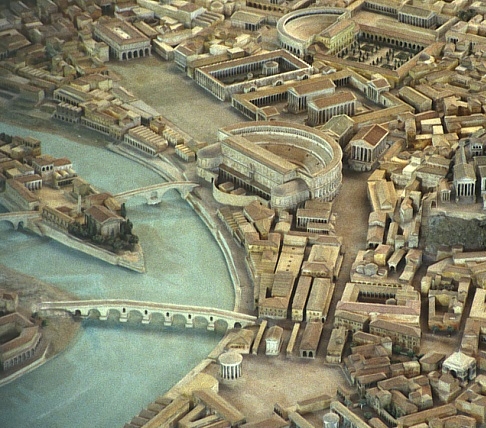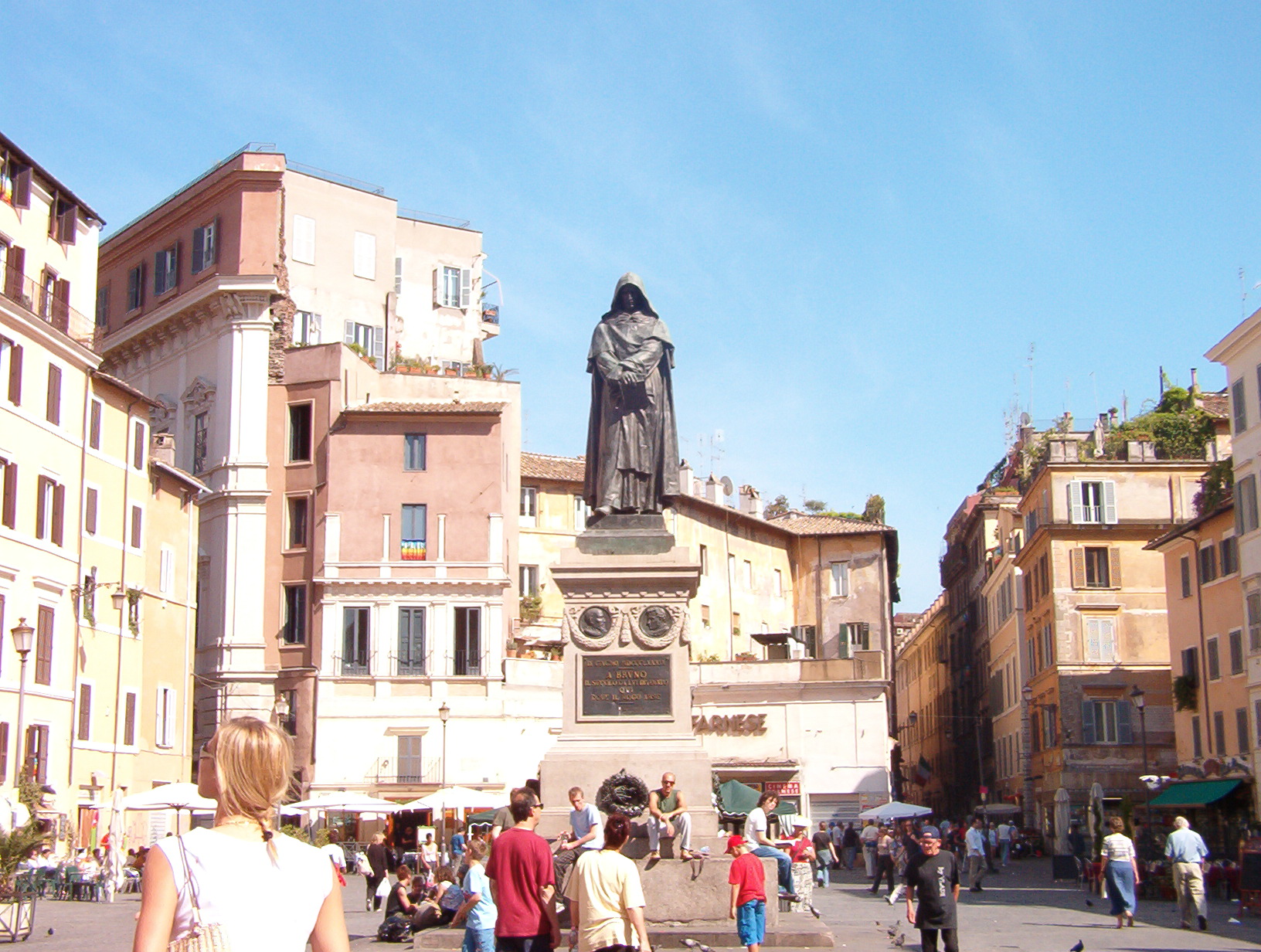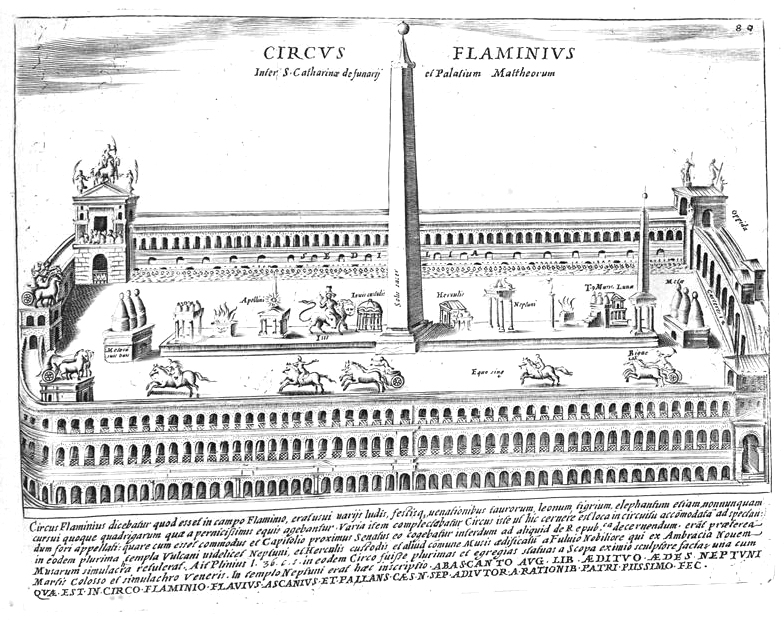|
Regola
Regola is the 7th ''rione'' of Rome, Italy, identified by the initials R. VII, and belongs to the Municipio I. The name comes from ''Arenula'' (the name is recognizable in the modern ''Via Arenula''), which was the name of the soft sand (''rena'' in Italian) that the river Tiber left after the floods, and that built strands on the left bank. The inhabitants of the ''rione'' are called ''Regolanti''. They were nicknamed ''mangiacode'' ('tail-eaters'), after the typical dish ''coda alla vaccinara'', which was a specialty of the many ''vaccinari'' ('butchers') of the ''rione''. The seal of the ''rione'' represents a rampant deer with a turquoise background. History During the Roman empire, the area belonged to the ''Campus Martius''. In particular, in the modern Regola there was the Trigarium, the stadium where the riders of the ''triga'' (a cart with three horses) used to train. When Emperor Augustus divided Rome into 14 regions, the modern Regola belonged was included in the I ... [...More Info...] [...Related Items...] OR: [Wikipedia] [Google] [Baidu] |
Rioni Of Rome
A rione of Rome (, pl. ''rioni'') is a traditional administrative division of the city of Rome. "Rione" is an Italian term used since the 14th century to name a district of a town. The term was born in Rome, originating from the administrative divisions of the city. The word comes from the Latin word ''regio'' (pl. ''regiones'', meaning region); during the Middle Ages the Latin word became ''rejones'', from which ''rione'' comes. Currently, all the rioni are located in Municipio I of Rome. Ancient Rome According to tradition, Servius Tullius, sixth king of Rome, first divided the city into ''regiones'', numbering four. During administrative reorganization after the Roman Republic collapsed, the first emperor Augustus created the 14 ''regiones'' of Rome that were to remain in effect throughout the Imperial era, as attested by the 4th-century ''Cataloghi regionari'', that name them and provide data for each. All but ''Transtiberim'' (the modern Trastevere) were on the left bank o ... [...More Info...] [...Related Items...] OR: [Wikipedia] [Google] [Baidu] |
Sant'Angelo (rione Of Rome)
Sant'Angelo is the 11th ''rioni of Rome, rione'' of Rome, Italy, located in Municipio I. Often written as ''rione XI - Sant'Angelo'', it has a coat of arms with an angel on a red background, holding a palm branch in its left hand. In another version, the angel holds a sword in its right hand and a Weighing scale, scale in its left. Sant'Angelo, the smallest of Rome's rioni, lies along the Tiber river east of Isola Tiberina, Tiber Island. Rioni bordering this district, clockwise from north to south, include Regola (rione of Rome), Regola, Sant'Eustachio (rione of Rome), Sant'Eustachio, Pigna (rione of Rome), Pigna, Campitelli, and Ripa (rione of Rome), Ripa. Sant'Angelo's western border is the river. The rione's terrain is low and flat and, until the construction of the Lungotevere, particularly susceptible to flooding from the river. The historical significance of Sant'Angelo is mainly the result of the presence here of the Roman Ghetto. History Roman Age: ''Circus Flamini ... [...More Info...] [...Related Items...] OR: [Wikipedia] [Google] [Baidu] |
Municipio I
Municipio I is an administrative subdivision of the municipality of Rome, encompassing the centre of the city. It was first created by Rome's city council on 19 January 2001 and has a president who is elected during the mayoral elections. On 11 March 2013 its borders were modified and it was expanded with the incorporation of part of the abolished ''Municipio XVII''. Since then all the rioni of Rome, which are the city's historic districts, form part of Municipio I together with the localities ''Delle Vittorie'' and ''Eroi''. Subdivision Municipio I is divided into 11 localities: Rioni Since 2013 the territory includes all 22 ''rioni'': R.I '' Monti'', R.II ''Trevi'', R.III ''Colonna'', R.IV ''Campo Marzio'', R.V '' Ponte'', R.VI ''Parione'', R.VII ''Regola'', R.VIII ''Sant'Eustachio'', R.IX '' Pigna'', R.X ''Campitelli'', R.XI '' Sant'Angelo'', R.XII '' Ripa'', R.XIII ''Trastevere'', R.XIV '' Borgo'', R.XV ''Esquilino'', R.XVI '' Ludovisi'', R.XVII ''Sallustiano'', R.XVIII ... [...More Info...] [...Related Items...] OR: [Wikipedia] [Google] [Baidu] |
Campo De' Fiori
Campo de' Fiori (, literally "field of flowers") is a rectangular square south of Piazza Navona in Rome, Italy, at the border between rione Parione and rione Regola. It is diagonally southeast of the Palazzo della Cancelleria and one block northeast of the Palazzo Farnese. ''Campo de' Fiori'', translated literally from Italian, means "field of flowers". The name dates to the Middle Ages when the area was a meadow. History In Ancient Rome, the area was unused space between Pompey's Theatre and the flood-prone Tiber. Though the Orsini established themselves on the south flank of the space in the 13th century, until the 15th century, the square remained undeveloped. The first church in the immediate vicinity was built during the pontificate of Boniface IX (1389–1404), Santa Brigida a Campo de' Fiori; with the building-up of the ''rione'', the church has now come to face that part of the former square that is now Piazza Farnese. In 1456, under Pope Callixtus III, Ludovico Cardin ... [...More Info...] [...Related Items...] OR: [Wikipedia] [Google] [Baidu] |
Coda Alla Vaccinara
Coda alla vaccinara is an oxtail stew in modern Roman cuisine including various vegetables, notably celery. The tail is considered offal, nicknamed in Rome the '' quinto quarto'' 'the fifth fourth'. Preparation The oxtail is parboiled and then simmered with large amounts of celery (typically 1.5 kilo of celery for every kilo of tail), carrots, and aromatic herbs. Tomatoes and red wine are added, and then the mixture is cooked further with a soffritto of onions, garlic, prosciutto, pancetta and some other ingredients. During the final phase of cooking, a bouquet garni of bay leaves, celery stalks, and cloves is put in the pot for flavouring. It is cooked until the meat easily separates from the bones. It is seasoned with cinnamon, nutmeg, and black pepper and garnished with pine nuts. ''Coda'' is usually prepared to taste sweet-and-sour, usually using raisins, or sometimes candied fruit or a small amount of grated bittersweet chocolate. Coda is generally prepared in advance and re ... [...More Info...] [...Related Items...] OR: [Wikipedia] [Google] [Baidu] |
Sant'Eustachio (rione Of Rome)
Sant'Eustachio is the 8th ''rione'' of Rome, identified by the initials R. VIII. It is named after the eponymous church and is located within the Municipio I. Its coat of arms depicts the head of a stag with a cross between the antlers, symbol of Saint Eustace: the figure is golden on a red background. Geography Northward, Sant'Eustachio borders with Campo Marzio (R. IV), whose boundary is defined by Piazza in Campo Marzio, Via della Stelletta and Via dei Portoghesi. It also borders with Ponte, from which is separated by Via dei Pianellari, Piazza di Sant'Agostino, Via di Sant'Agostino and Piazza delle Cinque Lune. To the west, the ''rione'' borders with Parione (R. VI), from which is separated by Piazza delle Cinque Lune, Corso del Rinascimento, Corso Vittorio Emanuele II, Largo dei Chiavari and Via dei Chiavari. Southward, Sant'Eustachio borders with Regola (R. VII), the boundary being outlined by Via dei Giubbonari, Piazza Benedetto Cairoli, Via Arenula and Via di Sa ... [...More Info...] [...Related Items...] OR: [Wikipedia] [Google] [Baidu] |
Parione
Parione is the 6th ''rione'' of Rome, identified by the initials R. VI, and belongs to the Municipio I. Its name comes from the fact that in the area there was a huge ancient wall, maybe belonging to the stadium of Domitianus; the nickname people gave to this wall was ''Parietone'' ("big wall" in ancient Italian), from which the name "Parione". The coat of arms of the ''rione'' depicts a rampant griffon, a Greek mythological creature with the head of an eagle and the body of a lion. It was chosen as a symbol of pride and nobility. History During Antiquity, it belonged to the IX Augustan region called ''Circus Flaminius''. In this area Domitianus built his stadium and an ''Odeon'' (''Odeum'' in Latin), for musical and poetic competitions. Pompey too built there his ''curia''. Around the 1200 the area was called ''Parione e S. Lorenzo in Damaso'' and the population kept on increasing until the 15th century, when the borough obtained a great importance thanks to the pavi ... [...More Info...] [...Related Items...] OR: [Wikipedia] [Google] [Baidu] |
Ponte (rione Of Rome)
Ponte is the 5th ''rione'' of Rome, identified by the initials R. V, and is located in Municipio I. Its name (meaning "bridge" in Italian) comes from Ponte Sant'Angelo, which connects Ponte with the rione of Borgo. This bridge was built by Emperor Hadrian (and originally was named after him ''Pons Aelius'') in 134 AD to connect his mausoleum to the rest of the city. Though Pope Sixtus V changed the ''rione'' limits, so that the bridge belongs now to Borgo, not to Ponte anymore, the area has kept its name and a bridge as its coat of arms. History In ancient Rome, the area belonged to the IX Augustan region called ''Circus Flaminius'', that was a part of the Campus Martius. Nero built another bridge, that was called '' Neronianus'' or ''triumphalis'' because the Via Triumphalis, the Triumphal Way, passed over it: starting with Titus, the victorious Emperors celebrating their Triumphs entered Rome marching through it. Nero's bridge was also called ''Pons Vaticanus'' (meaning "V ... [...More Info...] [...Related Items...] OR: [Wikipedia] [Google] [Baidu] |
14 Regions Of The Augustan Rome
Fourteen or 14 may refer to: * 14 (number), the natural number following 13 and preceding 15 * one of the years 14 BC, AD 14, 1914, 2014 Music * 14th (band), a British electronic music duo * ''14'' (David Garrett album), 2013 *''14'', an unreleased album by Charli XCX * "14" (song), 2007, from ''Courage'' by Paula Cole Other uses * ''Fourteen'' (film), a 2019 American film directed by Dan Sallitt * ''Fourteen'' (play), a 1919 play by Alice Gerstenberg * ''Fourteen'' (manga), a 1990 manga series by Kazuo Umezu * ''14'' (novel), a 2013 science fiction novel by Peter Clines * ''The 14'', a 1973 British drama film directed by David Hemmings * Fourteen, West Virginia, United States, an unincorporated community * Lot Fourteen, redevelopment site in Adelaide, South Australia, previously occupied by the Royal Adelaide Hospital * "The Fourteen", a nickname for NASA Astronaut Group 3 * Fourteen Words, a phrase used by white supremacists and Nazis See also * 1/4 (other) * Fo ... [...More Info...] [...Related Items...] OR: [Wikipedia] [Google] [Baidu] |
Circus Flaminius
The Circus Flaminius was a large, circular area in ancient Rome, located in the southern end of the Campus Martius near the Tiber River. It contained a small race-track used for obscure games, and various other buildings and monuments. It was "built", or sectioned off, by Gaius Flaminius in 221 BC. After Augustus divided the city into 14 administrative regions, the Circus Flaminius gave its name to Regio IX, which encompassed the Circus and all of the Campus Martius west of the Via Lata. Topography and structures In its early existence, the Circus was a loop, approximately 500 meters in length stretching across the Flaminian Fields (''Prata Flaminia''). Varro states that the actual Circus was built around the Fields, which were already a hallowed site for games by the time the Circus was laid in 220 BC. The '' ludi Taurei'' were hosted in the Fields since they were inaugurated by Rome's last king Lucius Tarquinius Superbus (d. 495 BC). During the 2nd century BC, this broad spa ... [...More Info...] [...Related Items...] OR: [Wikipedia] [Google] [Baidu] |
Middle Ages
In the history of Europe, the Middle Ages or medieval period lasted approximately from the late 5th to the late 15th centuries, similar to the post-classical period of global history. It began with the fall of the Western Roman Empire and transitioned into the Renaissance and the Age of Discovery. The Middle Ages is the middle period of the three traditional divisions of Western history: classical antiquity, the medieval period, and the modern period. The medieval period is itself subdivided into the Early, High, and Late Middle Ages. Population decline, counterurbanisation, the collapse of centralized authority, invasions, and mass migrations of tribes, which had begun in late antiquity, continued into the Early Middle Ages. The large-scale movements of the Migration Period, including various Germanic peoples, formed new kingdoms in what remained of the Western Roman Empire. In the 7th century, North Africa and the Middle East—most recently part of the Eastern Ro ... [...More Info...] [...Related Items...] OR: [Wikipedia] [Google] [Baidu] |
Borgo (rione Of Rome)
Borgo (sometimes called also I Borghi) is the 14th ''Rioni of Rome, rione'' of Rome, Italy. It is identified by the initials R. XIV and is included within Municipio I. Its coat of arms shows a lion (after the name "Leonine City", which was also given to the district), lying in front of three mounts and a star. These – together with a Heraldry, lion rampant – are also part of the coat of arms of Pope Sixtus V, who annexed Borgo as the 14th rione of Rome. History Roman Age: ''Ager Vaticanus'' During the Roman age, the Borgo district was part of the 14th 14 regions of the Augustan Rome, Regio (Regio XIV Transtiberim) and was named ''Ager Vaticanus'', after the auguries (''vaticinii'') performed there by the Etruscan civilisation, Etruscan ''Augurs''. Since it lay outside the Pomerium (the religious city border inside which burial was forbidden) and was plagued by malaria, this territory was used as a burial place. Some tombs reached notable proportions, including the ''Terebinth ... [...More Info...] [...Related Items...] OR: [Wikipedia] [Google] [Baidu] |


_-_Old_sign.jpg)


